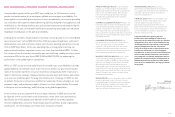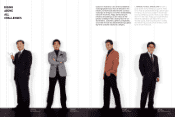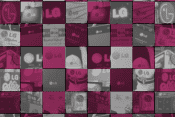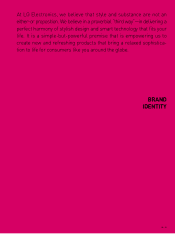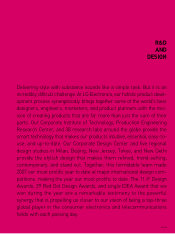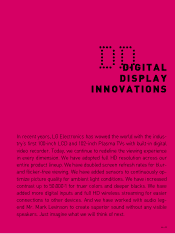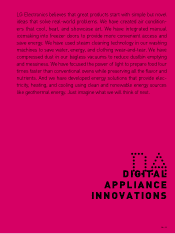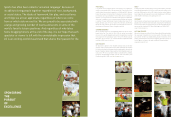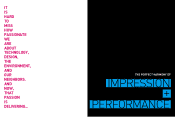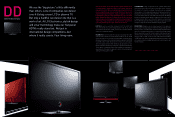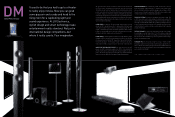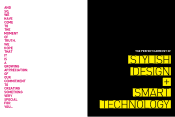LG 2007 Annual Report Download - page 20
Download and view the complete annual report
Please find page 20 of the 2007 LG annual report below. You can navigate through the pages in the report by either clicking on the pages listed below, or by using the keyword search tool below to find specific information within the annual report.
ELIMINATING HAZARDOUS SUBSTANCES
As part of our environmental commitment, we are committed to
meeting and exceeding the world’s toughest environmental standards.
The EU’s RoHS Directive has been our focus for the past few years.
Known best for its banning of the use of lead, RoHS also restricts
the use of three other heavy metals—mercury, cadmium, and
hexavalent chromium—as well as polybrominated biphenyls and
polybrominated diphenyl ether, both commonly used as flame retar-
dants in plastics. Our progressive internal guidelines are significantly
stricter than RoHS, and we continue to work closely with our sup-
pliers to ensure that raw materials, packaging materials, batteries,
and other sourced components meet our high standards. We are
currently taking the next step toward environmental sustainability by
phasing out our use of volatile organic compounds, PVC, brominated
flame retardants, and other substances identified as hazardous by
environmental NGOs.
ENHANCING EFFICIENCY
There is a hidden price to pay for all the modern conveniences we
enjoy today. Everything that plugs into an electrical circuit consumes
electricity, even when it is in standby mode or turned off. In August
2005, we launched an initiative to limit the standby consumption of
our products to one watt or less. As of 2007, we have achieved this
goal for the vast majority of our product lines as well as substantially
exceeding it for certain categories such as washing machines (0.3
watts) and LCD TVs (0.5 watts). This is just a part of our ongoing ef-
forts to reduce the power consumption of our products to save our
consumers money and help conserve our energy resources.
EXPANDING RECYCLING
We believe that one of the greatest environmental contributions we can
make is to ensure future generations do not find our products piled up in
a junkyard or buried in a landfill. We currently use a number of holistic
design approaches to make our products easy and efficient to recycle
at the end of their service lives. For example, our home-grown ATROiD
software enables us to evaluate the recyclability of products from the
initial stages of design, providing our designers and developers with
invaluable insights on how to ensure the best use of our planet’s finite
resources. We are also involved in major industry e-waste recycling
initiatives such as the European Recycling Platform and the Electronics
Manufacturers Coalition for Responsible Recycling in the US.
It has been 14 years since we made history by being Korea’s first
major consumer electronics company to make a public
commitment to environmental sustainability in 1994. In the years
that have passed, our commitment has grown and taken on new
dimensions. We have continued to make our products more
environmentally friendly by systematically and proactively
eliminating the use of hazardous substances in manufacturing,
boosting energy efficiency, and making them easier to recycle.
Our products are now among the industry’s greenest, and we
continue to innovate with new materials, processes, and
technologies that will help ensure a sustainable future for us,
our industry, and the world.
WORKING
FOR
A
GREENER
FUTURE
AIR CONDITIONERS
Heating and cooling equipment
requires lots of electricity to keep
us comfortable. Our air conditioner
outdoor units feature inverter
compressor technology that reduces
both power consumption and
noise. We use R-410A refrigerant
because it does not contribute to
ozone depletion. Our indoor units
also have washable filters,
eliminating another source
of waste.
LCD TVs
As flat-panel TVs get larger,
their power consumption rises
dramatically. We have reduced the
standby power consumption of our
LCD TVs to under 1 watt. We have
also developed a new technology
called “Eye’Q Green” that
dynamically adjusts picture quality
to match ambient light conditions
with the added benefit of improving
energy efficiency by up to 60%. As
with our other products, we have
eliminated the use of Deca-BDE
in plastics.
MOBILE PHONES
Considering that a billion or so
phones are sold and discarded
worldwide each year, eco-design
can have a big impact. Our mobile
phones now ship with power
adapters that consume just 0.11
watts when not charging. All
components are RoHS compliant,
plastics are free of Deca-DBE
flame retardant, and the main
circuit board is halogen-free.
Nickel, a metal known to cause skin
irritation in some individuals, is not
used in any surface that comes in
frequent contact with the face.
REFRIGERATORS
Like air conditioners, refrigerators
are big consumers of power. Our
refrigerators are among the world’s
most energy efficient thanks to
inverter linear compressors,
highly efficient heat insulators, and
optimized airflows. We have also
eliminated the use of Deca-BDE in
plastics and adopted eco-friendly
R-600A refrigerant and
cyclopentane foam insulation.
DVD REWRITERS
Almost every computer peripheral
comes with an external power
adapter. We designed our latest
DVD rewriter to get its power from
the USB data cable and consume
just 0.2 watts of power when idle.
The elimination of the power
adapter also means less
packaging and cheaper shipping.
The unit uses non-halogen flame
retardant and is marked for
easy recycling.
34 + 35


